When we read the memoirs, diaries, and other accounts of our ancestors, we often see oblique references to the people they traveled with along the Oregon Trail, or the people they had as neighbors in the mountains and valleys of the Promised Land.
The Trail of 1843 is recognized as the first large scale movement of emigrants bound for Oregon. Numerous chronicles of that journey exist, such as the comprehensive “Blazing A Wagon Trail To Oregon, A Weekly Chronicle of the Great Migration of 1843” by Lloyd W. Coffman (linked here in its entirety).

See also: History of Oregon (Bancroft)/Volume 1/Chapter 15 – The Immigration of 1843
This gathering of around 700 people, 110 wagons, and large herds of cattle (numbers vary depending on the sources) were about to face virtually the unknown. They would create the trail that others would follow over the next forty years, and would face hardships they could not have imagined.
In the long line of wagons, Sarah Jane Reed Hill, age 20, was also beginning a journey that would change her life as dramatically as it would for all those venturing west. Adverse weather conditions, lack of provisions, conflict of personalities, illness, skirmishes with Indians, and death along the trail translated to stories that would be told to their descendants.
So it was that Sherry Blackburn Hoefel, the 3rd great granddaughter of Sarah Jane Reed Hill, reached out to me one day, and said she had a remarkable story to share, the story of that twenty-year-old girl who would come to be called the Queen of Pioneers.
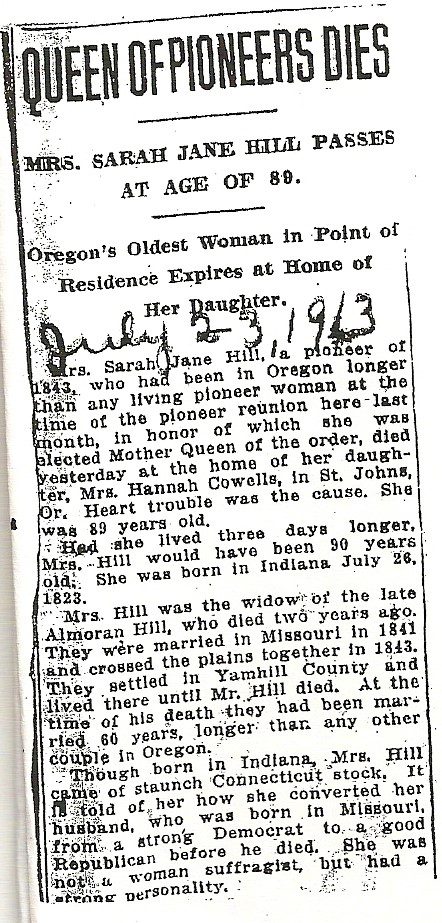
“Memoirs of the Oregon Trail” is unique among all the stories that exist about the Trail of 1843. It is a blend of three perspectives, family members telling the same story, but with their own unique way of relating the story, of blending events, of spelling and prose.

“Memoirs of the Oregon Trail“
Part One is from Margaret Mae Money Rodgers, the granddaughter of Sarah Jane, written in 1957.
Part Two is from Martha Williams Reed, the wife of Sarah Jane’s brother written in 1917.
Part Three is from Sarah Jane herself, written about 1883.
As remarkable as these three versions are, as brutally detailed they are in describing the hardships and events endured, as poignant are the reminiscences, there is an entirely different story that evolves from between the lines of this family story.
In my opening I stated, “we often see oblique references to the people they traveled with.” We read the stories of the Oregon Trail, focusing on the recollections of an individual, and often ignore references to people they encountered along the way or traveled with.
As I read “Memoirs of the Oregon Trail” I was struck by the immensity of Oregon history that was soon to erupt once Sarah Jane and her fellow emigrants arrived in the Northwest. For here in the “Memoirs” we catch glimpses of the individuals before they made their mark shaping the history of Oregon. The people she casually mentions in the “Memoirs” evolve to be a veritable Who’s Who of Oregon history.
Joseph Lafayette “Joe” Meek (February 9, 1810 – June 20, 1875) was a pioneer, mountain man, law enforcement official, and politician in the Oregon Country and later Oregon Territory of the United States. A trapper involved in the fur trade before settling in the Tualatin Valley, Meek played a prominent role at the Champoeg Meetings of 1843, where he was elected a sheriff. He was later elected to and served in the Provisional Legislature of Oregon before being appointed as the United States Marshal for the Oregon Territory.

Jesse Applegate (July 5, 1811 – April 22, 1888) was an American pioneer who led a large group of settlers along the Oregon Trail to the Oregon Country. He was an influential member of the early government of Oregon, and helped establish the Applegate Trail as an alternative route to the Oregon Trail.
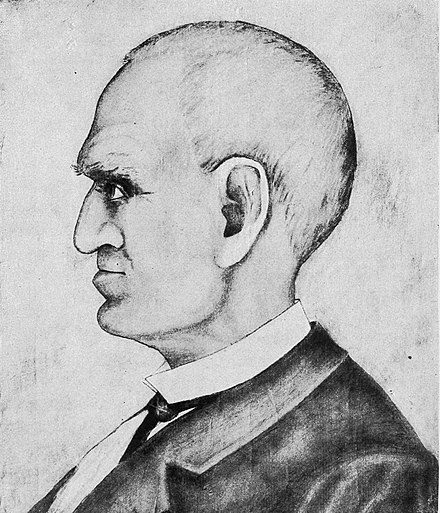
Marcus Whitman (September 4, 1802 – November 29, 1847) was an American physician and missionary. In 1836, Marcus Whitman led an overland party by wagon to the West. He and his wife, Narcissa, along with Reverend Henry Spalding and his wife, Eliza, and William Gray, founded a mission at present-day Walla Walla, Washington in an effort to convert local Indians to Christianity. In the winter of 1842, Whitman went back east, returning the following summer with the first large wagon train of settlers across the Oregon Trail. These new settlers encroached on the Cayuse Indians living near the Whitman Mission and were unsuccessful in their efforts to Christianize the tribe. Following the deaths of many nearby Cayuse from an outbreak of measles, some remaining Cayuse accused Whitman of murder, suggesting that he had administered poison and was a failed shaman. In retaliation, a group of Cayuse killed the Whitmans and eleven other settlers on November 29, 1847, an event that came to be known as the Whitman massacre. This led to continuing warfare between settlers and the Cayuse which reduced their numbers further.

David Thomas Lenox (December 8, 1802 – October 18, 1874) was an American pioneer who settled in the Oregon Country where he organized the first Baptist Church west of the Rocky Mountains. A native of New York, he lived in Illinois and Missouri before he was captain of the first wagon train over the Oregon Trail to what became the state of Oregon.[1] He also organized several schools and churches, and served as a judge and justice of the peace. In Oregon, he settled on the Tualatin Plains near what is now Hillsboro and later lived in Eastern Oregon.

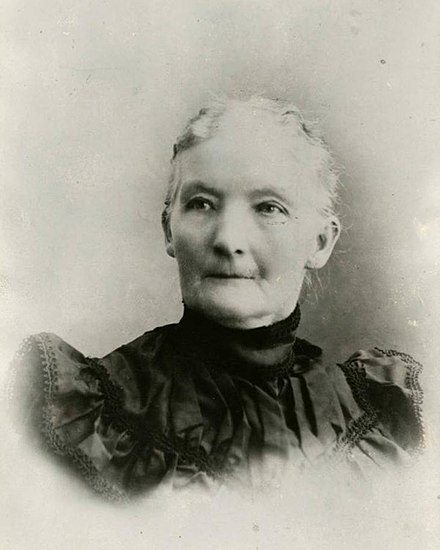
Henry Harmon Spalding (1803–1874) and his wife Eliza Hart Spalding (1807–1851) were prominent Presbyterian missionaries and educators working primarily with the Nez Perce in the U.S. Pacific Northwest. The Spaldings and their fellow missionaries were among the earliest Americans to travel across the western plains, through the Rocky Mountains and into the lands of the Pacific Northwest to their religious missions in what would become the states of Idaho and Washington. Their missionary party of five, including Marcus Whitman and his wife Narcissa and William H. Gray, joined with a group of fur traders to create the first wagon train along the Oregon Trail.[1]
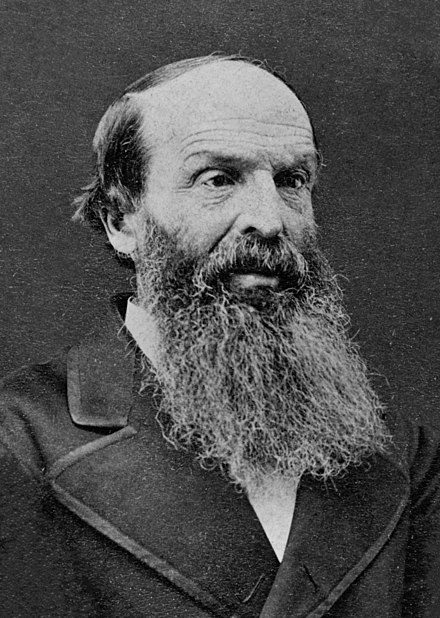
John C. Frémont (born January 21, 1813, Savannah, Georgia, U.S.—died July 13, 1890, New York, New York) American military officer and an early explorer and mapmaker of the American West, who was one of the principal figures in opening up that region to settlement and was instrumental in the U.S. conquest and development of California. He was also a politician who ran unsuccessfully for the U.S. presidency in 1856 as the first candidate of the newly formed Republican Party.

John Bidwell (August 5, 1819 – April 4, 1900), known in Spanish as Don Juan Bidwell,[1] was a Californian pioneer, politician, and soldier. Bidwell is known as the founder of the city of Chico, California.
Born in New York, he emigrated at the age of 22 to Alta California (then a part of Mexico) as part of the Bartleson–Bidwell Party, one of the first expeditions of American emigrants along the California Trail. In California, he became a Mexican citizen and a prominent landowner, receiving multiple rancho grants from the governors of Alta California. Following the U.S. Conquest of California, Bidwell went on to serve in the California Senate and then in the U.S. House of Representatives.
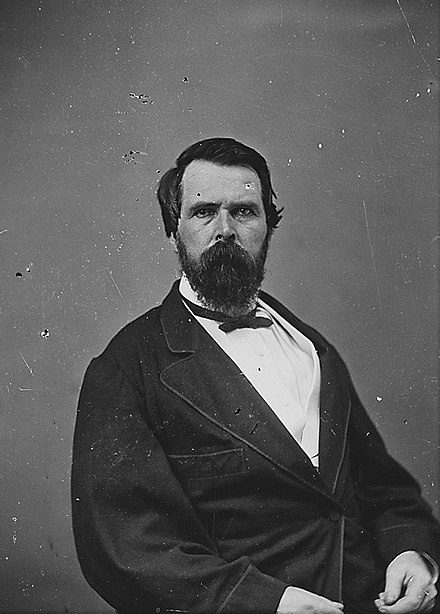
Peter Hardeman Burnett (November 15, 1807 – May 17, 1895) was an American politician who served as the first elected Governor of California from December 20, 1849, to January 9, 1851. Burnett was elected Governor almost one year before California’s admission to the Union as the 31st state in September 1850.[2]
Raised in a slave-owning family in Missouri, Burnett moved westward after his business career left him heavily in debt.[3] Initially residing in Oregon Country, he became Supreme Judge of the Provisional Government of Oregon. While in Oregon politics, he pushed for the total exclusion of African Americans from the territory. He authored the infamous “Burnett’s lash law” that authorized the flogging of any free blacks who refused to leave Oregon;[4] the law was deemed “unduly harsh” and went unenforced before voters rescinding it in 1845.[5][3]
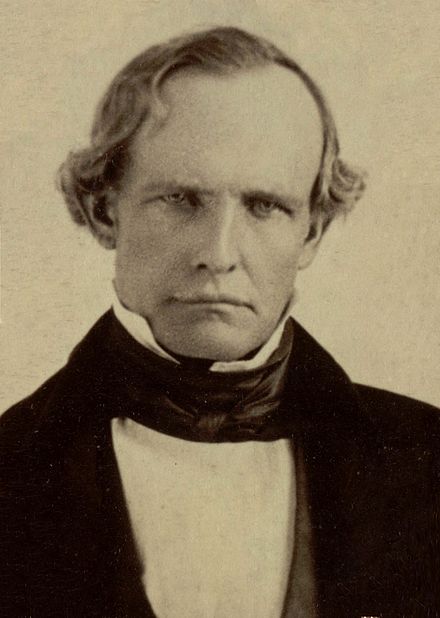
Elvira Johnson Perkin and the Reverand Henry Perkins –
“Hark! ‘tis the sound of wailing
Comes on the evening breeze,
Forth from an Indian village lone,
By yon dark forest trees.”

Jason Lee (June 28, 1803 – March 12, 1845) was a Canadian Methodist Episcopalian missionary and pioneer in the Pacific Northwest. He was born on a farm near Stanstead, Quebec. Jason Lee was the first of the Oregon missionaries and instrumental in the American settlement in the Oregon Country.

Jesse Quinn Thornton (1810–1888) was an American settler of Oregon, active in political, legal, and educational circles. He served as the 6th Supreme Judge of the Provisional Government of Oregon, presented Oregon’s petition for official territorial status to Congress, served in the Oregon Legislature, and wrote the state’s motto.
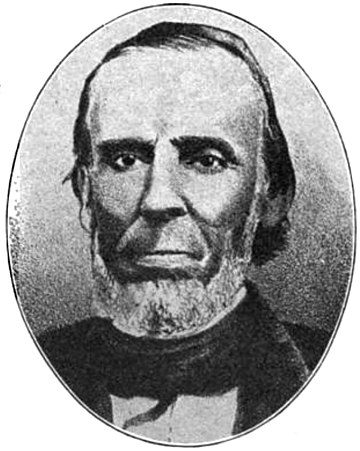
Judge White came to Oregon in 1845, crossing the plains with his family and three children, taking the old Meek cutoff. He engaged in farming near Oregon City and was interested in the steamer Lot Whitcomb, the first boat built on the Willamette River. Partners with him were Colonel Jennings and Lot Whitcomb. The ownership afterward passed to Captain J. C. Ainsworth.
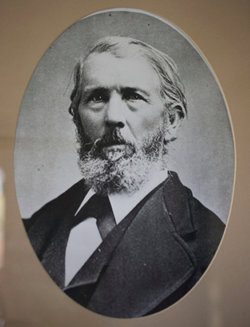
George Law Curry (July 2, 1820 – July 28, 1878) was a predominant American political figure and newspaper publisher in the region that eventually became the state of Oregon. A native of Pennsylvania, he published a newspaper in St. Louis, Missouri, before traveling the Oregon Trail to the unorganized Oregon Country. A Democrat, Curry served in the new Oregon Territory‘s government as a representative to the legislature and as Territorial Secretary before appointment as the last Governor of the Oregon Territory. Curry County in Southern Oregon is named in his honor.

Sarah Jane Reed Hill and her husband, Almoran Hill, were part of that great migration of 1843, encountered all of the historical figures mentioned here in their travels across the plains and/or through their endeavors in the Pacific Northwest. She was one of the first white women in the Territory, bore 14 children, and insured that the legacy of the Hill family carried forward. History lauds the achievements of these historical figures, but what goes untold is the story of a twenty-year-old girl who saw those men before they achieved infamy, who knew them as fellow travelers, friends, adventurers, and family. Behind them all, she truly was the Queen of Pioneers, and part of a remarkable Oregon family.




Liz Rapp
An excellent compilation of three stories from this family’s history. So interesting what we remember, what we forget, what we focus on and how others may see life experiences differently. Thanks for writing this for us.
Mgoddard
Thank you, I love researching them as much as I love sharing them!! Mark